Ok y’all. This is where things in our story start to get groovy. Our mystery is back in full stock this time as we take a break from the concurrent lenses to examining to an episode that masterfully utilizes its visuals to truly examine thematically where the precedent of “reality and fiction” is going in the show and the results of which wind up being fascinating to follow. The result winds up being one of my personal favorite episodes in the series that serves as a powerful but humorous full-force excursion into wonderland that only asks you take a comfortable seat.
So, they’ve finally done it. Our two detectives have apprehended Little Slugger and now have him all wrapped and bowed in the interrogation room. One of the first things you may notice upon entering is that the entire aesthetic has taken a step into the distant and simplified. Faces are stretched and undefined, backgrounds have almost a watercolor dreaminess about them (and, may I add, all of this works rather well for the dreamland that most of the episode is set in, but it can come across as somewhat jarring when also seen in the “real world”).
Makoto Kozuka’s the name, and his entire introduction scene is… well… pretty damn funny. As if ardently blabbering on about his mission as a “holy warrior” (naturally with a blaring trumpet theme song every time use of the word is mentioned) wasn’t enough, seeing our hard boiled and salted veteran’s circuits frying up as each useless minute in that office passes by, and crescendoing moments of epiphany flatten to dredging exacerbation that combine with some great use of match cutting. The whole scene just makes for some great, well done, winking melodrama.
From here on out, it’s a journey across this kids realized fantasy land to help crack the case of Lil’ Slugger. He envisions himself as a Holy Warrior, and the mission is simple: to defeat Gohma, a contagious evil that possesses our native “villagers”, the action of which is signified by a bright red aura around the victim. Of course, this stuff is all relative to the case at hand, and Kozuka’s ramblings prove rather useful to Maniwa, who’s right on the brats game, eventually taking the form of a wandering minstrel in the kids world as a natural recorder and observer in this cavalcade of things that demand to be seen. Well, it’s not like Ikari has all that much trouble connecting the dots between the kid’s world and his own himself (he’s no slouch, after all), he’s still entirely too grounded throughout the episode, and Gohma is a monster that demands to be fought on its own turf.
The representative visuals themselves that take form in the kids mind aren’t terribly important (it’s mostly summation, after all), although it is nice to see some imagery almost back-write the characters in a way that’s neatly explicit: Ichi= walking fish = desperate monster out of its element that’s defensively attacking everything around it, etc). It also helps when decoding all the craziness here to remember that every character has a corresponding derivative pun to their name (“cho” means butterfly, signifying Harumi’s opposing but symmetric personality, “Tai”, a red snapper, I already went through the possible connotation of that). Gotta love what Kon does with that stuff.
But before tumbling further down the rabbit hole, let’s examine just what this kid is trying to do here. He’s masqueraded as a levitating warrior on a “holy mission” (understanding the social phenomenon) that’s trying to find the answer to the already baffling question of our social phenomenon. This could indicate some sort of attempt at transcending their own personal understanding of reality to connect with something that already defies all logic. That, to me, is what this entire president of reality and fiction is, and will continue to be throughout the various threads of the show.
Ikari tries to eke any matter of concrete method to this kid’s madness by talking to the victims, but no dice. This is a matter that’s going to have to be settled on the player’s home ground, and Maniwa well knows that.
Right before the kid recalls Harumi’s story (taking the form of a tainted princess…hmm), Maniwa turns into a type of squire, which indicates a more assistive role in this event recollection (which makes sense, he’s starting to put more pieces together at this point). When the battle is won, excitement dies down, and events start corroborating to detective Ikari, he still can’t help but feel grounded by something, and that being his pack of smokes. All of a sudden he gives a pace-breaking speech about existing in the present world by accepting what’s just and right.
But before that particular sentiment can pass through, our knight, watch him go, gets “crushed” (caught) by Hirukawa. But before everyone comes back to the surface, Kozuka gives an essential clue about who might really know what this phantom menace might really be after all.
Handy Dandy Things to Look Out For:
*This episode sets in motion two very different fates for our detectives. Keep that in mind when shit goes down.
*The visuals get turned up to 11 from here on out, and it’s really effective for communicating the horror of everything later on, but you don’t necessarily need to decode everything to understand it.
Rachael’s a student at a Florida university that frolics regularly in Disney parks and has an entirely too extensive collection of stuffed animals. If you wanna follow her other random musings on cartoons (or just stop by to say hi) there’s her blog https://lotsofframes.wordpress.com/.
—Please make note of The Mary Sue’s general comment policy.—
Do you follow The Mary Sue on Twitter, Facebook, Tumblr, Pinterest, & Google +?









Published: Jul 31, 2015 02:09 pm